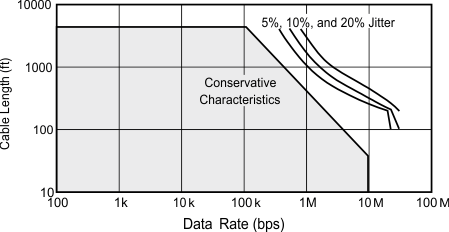JAJSLR8B April 2021 – September 2021 THVD1439 , THVD1439V , THVD1449 , THVD1449V
PRODUCTION DATA
- 1 特長
- 2 アプリケーション
- 3 概要
- 4 Revision History
- 5 Pin Configuration and Functions
- 6 Specifications
- 7 Parameter Measurement Information
- 8 Detailed Description
- 9 Application and Implementation
- 10Power Supply Recommendations
- 11Layout
- 12Device and Documentation Support
パッケージ・オプション
デバイスごとのパッケージ図は、PDF版データシートをご参照ください。
メカニカル・データ(パッケージ|ピン)
- D|8
サーマルパッド・メカニカル・データ
発注情報
9.2.1.1 Data Rate and Bus Length
There is an inverse relationship between data rate and cable length, which means the higher the data rate, the short the cable length; and conversely, the lower the data rate, the longer the cable length. While most RS-485 systems use data rates between 10 kbps and 100 kbps, some applications require data rates up to 250 kbps at distances of 4000 feet and longer. Longer distances are possible by allowing for small signal jitter of up to 5 or 10%.
 Figure 9-2 Cable Length vs Data Rate Characteristic
Figure 9-2 Cable Length vs Data Rate CharacteristicEven higher data rates are achievable (that is, 12 Mbps for the THVD1449(V)) in cases where the interconnect is short enough (or has suitably low attenuation at signal frequencies) to not degrade the data.